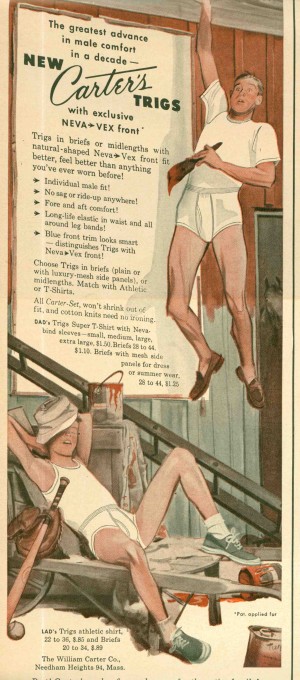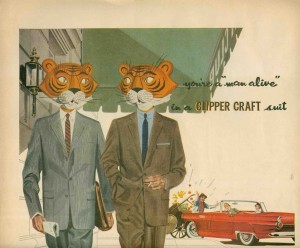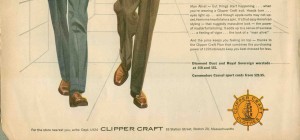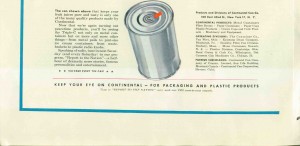Fashion
Follies of the Mad Men #33
I insist on having my next new car delivered by magical flaming meteor!
Posted By: Paul - Sat Oct 04, 2008 -
Comments (3)
Category: Business, Advertising, Fashion, Music, 1960s, Cars
Aristocrats of Fashion
Do you have enough Bemberg rayon clothes in your wardrobe? If not, watch this!(But be warned! Only a partial video remains to us down the ages. You'll never get to see the implied all-rayon wedding.)
Posted By: Paul - Tue Sep 30, 2008 -
Comments (3)
Category: Business, Advertising, Products, Fashion, 1930s, 1940s
The Tiger Lillies
Witness the weirdness that is the Tiger Lillies.
Posted By: Paul - Sun Sep 28, 2008 -
Comments (4)
Category: Art, Pop Art, Surrealism, Eccentrics, Fashion, Humor, Parody, Music, Theater and Stage, Body Painting
Follies of the Mad Men #30
[From Life magazine for June 9 1952.]This ad was part of a long campaign for the product, which depicted men and boys doing common tasks in public in their underwear. Kinda the male equivalent of the famous "I dreamed I went to work in my Maidenform bra" series of ads. No matter the possible plausible logic of the creators, this series conjures up nothing so much as a kind of weird nation solely populated by mentally challenged males, where outer clothing has yet to be invented.
Posted By: Paul - Thu Sep 25, 2008 -
Comments (17)
Category: Business, Advertising, Fashion, Stupidity, 1950s, Men
Baby High Heels
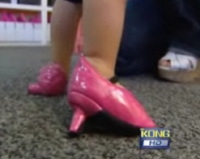
This must appeal to the same set of people who enter their six-year-old daughters in child beauty pageants. Yahoo! News has a video of a kid wearing these things. What about Baby Foot Binding next?
Posted By: Alex - Thu Sep 11, 2008 -
Comments (4)
Category: Babies, Fashion
Follies of the Mad Men #24
And now, something different for this series: a video titled DESIGN FOR DREAMING.
Posted By: Paul - Sun Sep 07, 2008 -
Comments (4)
Category: Business, Advertising, Products, Domestic, Fashion, Futurism, Inventions, Technology, Sex Symbols, 1950s, Cars
Follies of the Mad Men #20
[From Life for September 24 1956. Two separate scans, top and bottom.]
Judging by the reaction of the people in the background, these are either a) real transgenic tiger men walking down the street; or b) very convincing masks. In either case, the viewer is forced to ask, "Are tigers particularly famous for their sartorial choices?"
BONUS: this ad may serve as Furry porn, if you're so inclined.
Posted By: Paul - Mon Sep 01, 2008 -
Comments (2)
Category: Animals, Business, Advertising, Fashion, Sexuality, 1950s
Bowanga Bowanga
BOWANGA BOWANGA, or "The White Sirens of Africa," is a lot less fun over sixty minutes of viewing than this select snippet pretends. So be content with what you see here, and save yourself a rental.
Posted By: Paul - Sun Aug 24, 2008 -
Comments (6)
Category: Fashion, Hollywood, Movies, Nature, Sex Symbols, Foreign Customs, Marriage, 1950s, Dance
Follies of the Mad Men #13
[From Fortune for December 1945. Two scans, top and bottom.]
There is nothing spectacularly "weird" about this particular entry in our series, except that the artist is William Steig, the famed illustrator and author responsible, most notably in Hollywood terms, for Shrek. It's curious to see him turning his talents to advertising during his early career, as so many artists who later grew rich and famous once did.
Perhaps the true vestige of weirdness here, though, is the image of the proud boy wearing his Jughead cap. You can learn about the history of the Jughead beanie and how to make such a cap yourself at Juggie's Wikipedia page. Or perhaps you'd want to buy one readymade, either here or here.
But maybe you want to go for the entire Jughead look!
Posted By: Paul - Sun Aug 17, 2008 -
Comments (2)
Category: Business, Advertising, Products, Fashion, Hollywood, Literature, Books, Fantasy, Movies, Comics, 1940s
Atragon
Recently I watched the 1963 Japanese SF flick ATRAGON. I knew I was in true weirdo territory when the undersea empire of Mu turned out to be ruled by Cyndi Lauper.Not really, but check out the gal in the pink wig in this trailer for the film.
Posted By: Paul - Sat Aug 16, 2008 -
Comments (10)
Category: Boats, Explosives, Fashion, Hair Styling, Inventions, Movies, Science Fiction, 1960s

| Who We Are |
|---|
| Alex Boese Alex is the creator and curator of the Museum of Hoaxes. He's also the author of various weird, non-fiction, science-themed books such as Elephants on Acid and Psychedelic Apes. Paul Di Filippo Paul has been paid to put weird ideas into fictional form for over thirty years, in his career as a noted science fiction writer. He has recently begun blogging on many curious topics with three fellow writers at The Inferior 4+1. Contact Us |

